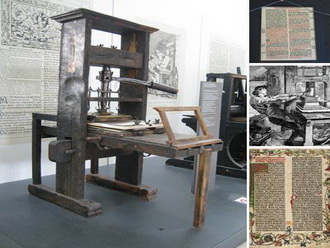
[Printing Industry]
WHAT IS printing industry?
Our first assignment after deciding the
search topic was to find some information about “printing industry”.
Let’s look into the history of printing…
Printing was not invented by one man only.
It was not suddenly invented in one year; it is the collective wisdom of wise
men from the past, accumulated the experiences in thousands of year and
gradually evolve into the final results. The production of printing matters is similar
to stamping. You carve the stamp first (in printing you make “printing plate”),
and you dip your stamp (plate) with some ink, then transfer the ink from the
stamp (plate) to materials like paper, cloth, or leather so they become printed
matters. This is the ancient printing. The pointed reversed pattern of ink (on
the plate) will print out as front side patterns on the paper. One dip or brush
(of ink) can print one copy, in Chinese we say one Shua刷 get one Yin印, that’s why we call it Yinshua印刷 in Chinese.
Printing industry is a processing service industry that they massively and rapidly copy pictures and letters on customers’ demands. It combines several different fields of knowledge like science, technology, art, and information. There are 5 elements to finish the process of printing copy. They are original copy, printing plate, paper, ink, and printing press.
The modern printing machines can use mechanical
device to press the inked plate to the printing materials (such as paper and
cloth), so they can get printed copy. It was invented by Gutenberg, a German in
1440. It can print not only words but also pictures. The modern printing
machines nowadays are usually consist of devices to load plates, dip ink, press
plate and deliver paper (and fold paper). The operating principle is similar:
carve words or picture on the plate, put the ink to the place with words and
pictures, and transfer directly or indirectly to papers or other printing
materials. The modern printing technology even digitalizes the carving part.
They use computer to separate the color into 4, make 4 colors of plates, and
send the plates to 4 color offset printing press for massive printing work.
 |
|
|
The printing machine invented by Gutenberg |
This is the modern printing machine, which
can print massive copies. It can print as many as 15,000 copies per hour. |
Print, print, print
The printed matters are various in types,
but we can roughly divide them into 4 main categories. If you categorize them
by the characters, there’re cultural print, commercial print, industrial print.
Here are the introductions:
(1)
Cultural print: As known as
publication, it is mainly used to spread knowledge. It usually applies to books,
newspapers, magazines, images, or stationaries, etc. It covers extensive range
and has the most variety among the four categories. Most of the publication
uses planographic printing. The product of cultural print is called printed
matters.
(2)
Commercial print: It is mainly
used to spread information for business, or promoting product, etc. It covers
posters, DM, flyers, labels, categories, packing materials, coupons and
marketable securities. From little things to bigger things. They are hundreds
of thousands in types. It mainly uses planographic printing, some use intaglio
printing or other printing method. Commercial print usually is part of the
product.
(3)
Industrial print: The purpose of
industrial print is adding more value or functions to the product. It covers circuit
boards, textiles, control panels, construction materials, glass, porcelain
products, toy, etc. The manufacturing methods vary with products. Most of the
commercial prints use screen printing. Printing is usually part of the manufacturing
procedure.
(4)
Fine printing: The goal of fine
printing is to reproduce the true color, true texture and the fine part of the artwork.
It needs to delicately show the artistic value of originally copy. The quality
is more important than the quantity. It covers copying famous artwork, graphic
art printing, wood-block printing, silk screen printing, photogravure printing,
engraving printing, etc.
|
Left image: The machine can directly print a book. It’s called cultural print; Right image: The packing material of the product is a commercial print. Both are belong to planographic printing, the target of our research! |
|
References:
National Science and Technology Museum館
The definition of the printing industry義
Google MapMap
Picture resource: GuangFu Research Team
All Rights Reserved
1024 X 768